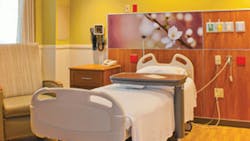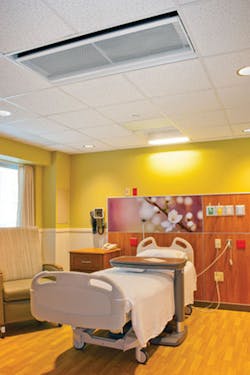Chilled Beams in Health-Care Patient Rooms
Health-care patient-room design is dictated by rigid environmental and safety requirements, which severely limit the types of systems deemed suitable for HVAC. These requirements are evaluated continually, which, on occasion, opens the door to more progressive and lower-energy technologies.
Such a time was 2011, when ASHRAE revised ANSI/ASHRAE/ASHE Standard 170-2008, Ventilation of Health Care Facilities, with the publication of Addendum h, allowing the use of recirculating-type heating and cooling units within non-invasive areas of hospitals, including patient rooms. The revision includes language indicating “induced” recirculation air qualifies as an “air exchange” for the purpose of compliance with room air-change-rate requirements of the standard. Additionally, the revision clarifies additional filtration is not required within recirculating room units designed to operate without condensing water on their surfaces, provided the primary ventilation air to the units is filtered in accordance with the standard.
Addendum h provided another option for energy-efficient heating and cooling of non-invasive areas of hospitals, particularly existing facilities with limited ceiling cavities. This was a huge step toward discussion of more progressive, more innovative, and lower-energy HVAC systems, such as active chilled beams, within the boundaries of regulatory requirements.
With patient-room design driven by fixed continuous ventilation rates and accurate control of those rates, chilled-beam systems are ideal, as their hydronic sensible cooling regulates space temperature while allowing constant-volume delivery of supply and ventilation air.
Used successfully in Europe for more than 20 years, chilled-beam systems have gained wide acceptance in North America as an alternative to traditional variable-air-volume (VAV) systems. This interest is fueled largely by chilled beams’ energy-saving potential, ease of use, low maintenance, and minimal space requirements. While all are important, the primary concern of health-care cooling/heating-system designers needs to be maintaining good indoor-air quality (IAQ) and mitigating airborne transmission of disease.
How Chilled Beams Work
Chilled beams are cooling (and optionally heating) units located in or above a conditioned space that utilize a ventilation-only primary air stream from a remote air handler to induce larger recirculating room flows, effectively heating, cooling, and ventilating the space without the use of an in-room fan and with reduced overall airflow from the central air-handling unit (AHU).
The cooling capacity of active chilled beams is much greater than that of passive chilled beams. While passive chilled beams rely on natural convection for cooling, active chilled beams have a duct connection through which primary air is introduced and strategically positioned slots through which room air is induced through the cooling coil. With an adjustment of the width of the slots, the ratio of induction air to primary air can be varied from about 1:1 to about 4:1, and the amount of cooling capacity achieved, outdoor air provided, and supply air delivered can be modified to meet the air-change and sensible-cooling/heating needs of a patient room.
Benefits of Active Chilled Beams in Health Care
Facilitywide benefits of implementing active chilled beams include downsized ductwork/equipment, energy reductions of up to 50 percent (dependent on system design, building details, and climate zone), and decreased maintenance. Benefits specific to health care and patient rooms include:
• Optimum comfort and IAQ. An active-chilled-beam system controls both temperature and humidity in an occupied space. With a constant supply of primary air, minimum outdoor-air ventilation requirements are met at all conditions and in all spaces. ANSI/ASHRAE Standard 62.1, Ventilation for Acceptable Indoor Air Quality, requires a chilled-beam system to process less outdoor air than a recirculating VAV system. Air from beams is distributed evenly throughout a space, reducing the risk of drafts and cold-air “dumping” while supplying a greater flow of air (because of induced room air) than a VAV system at peak conditions. Testing has shown not only improvement in overall thermal comfort with chilled beams, but greater comfort and temperatures more consistent with the room thermostat around patient beds.
• Reduced risk of cross-contamination. Mechanical filtration has proven effective in producing virtually bacteria-free return air in hospitals. Viruses and many gases, however, cannot be filtered. Introducing 100 percent outdoor air to a patient room reduces the risk of airborne infection by eliminating room-to-room air transfer. Additionally, when chilled beams are designed properly, there is no condensation on the coil to collect dust and dirt, and because inspection and cleaning of the coil and induction grille can be performed from the face of the unit, ceiling tiles do not have to be disturbed.
• Quiet operation. High ambient-noise levels in patient rooms can have serious impacts on patients, ranging from sleep loss and elevated blood pressure to extended recovery times. Properly designed active-chilled-beam systems contribute virtually no detectable noise to occupied spaces, with sound-power levels at or below 25 db.
• Eliminated or reduced reheat. Compared with a conventional overhead mixed-air constant-volume or VAV system, an active-chilled-beam system can reduce the volume of primary air it supplies by 30 to 60 percent. The lesser the amount of primary air, the lesser the amount of terminal reheat required, which can result in significant operational-cost savings. This particularly is the case with patient rooms, in which the air system typically is constant volume to meet minimum-total-air-change requirements.
Challenges
Challenges associated with the use of active chilled beams in health-care settings include:
• Condensation prevention. Avoiding condensation on ceiling-mounted “cooled” coils (active beams) requires accurate estimation of internal latent loads and effective control of indoor humidity. As long as indoor humidity is controlled and beam supply-water temperature is maintained above the dew point of the space, condensation is of no greater concern than it is with a conventional all-air system.
• Industry perception. Chilled beams are fairly new to the United States and even newer to the health-care industry. Owners and engineers with little or no familiarity with the technology either shy away from its use or apply it improperly.
• Cleanliness. Large amounts of bedding are used in patient-care areas of hospitals. Lint from this bedding becomes airborne and can accumulate in HVAC duct-work. Although chilled beams do not usually attract large amounts of lint—the velocity of the air moving over them is too low—it still is a good idea to perform routine maintenance on them. Chilled-beam manufacturers offer removable faces for first-stage cleaning, removable coils for second-stage cleaning, and, in some cases, lint screens.
• Building envelope. Chilled beams require a tight building envelope to prevent moisture infiltration from the outside and the loss of room humidity control. The dew point of the air in the space must remain above the temperature of the beams.
Approach
Depending on the size, orientation, and layout of a patient room, chilled beams can be installed perpendicular or parallel to the perimeter wall. Perpendicular is recommended. Parallel installation can result in drafts and patient discomfort, as during intermediate seasons, when internal cooling is required and window surfaces are cool, an increase in air velocity can occur.
In patient rooms, two-way or one-way beams typically are used. With multiple sizes and nozzle configurations available, two-way beams offer a flexibility allowing them to be applied in most applications. One-way beams typically are used in perimeter zones and/or smaller rooms, usually above the patient bed, along the side wall.
Flow-pattern control allows testing, adjusting, and balancing contractors and facilities engineers to direct supply air from a beam as needed to fit a space configuration, compensate for heat gain through windows, and accommodate comfort needs of patients. Optimal orientation and design target values can be verified with a full-scale mock-up or computational fluid dynamics.
For a typical 220-sq-ft patient room with 9-ft ceiling and 4,500-Btuh sensible load, the minimum total air required (6 air changes per hour [ACH]) is 200 cfm, and the minimum outdoor air (2 ACH) is 70 cfm. Rather than supply 245 cfm of 55ºF air from a mixed-zone recirculation AHU to satisfy a sensible load, a 6-ft chilled beam served by 57ºF chilled water and 70 cfm of 55ºF primary outdoor air will deliver approximately 4,500 Btuh of sensible cooling at an effective 275-cfm supply airflow and very low sound level (20 db). That is a 70-percent reduction in required airflow.
Conclusion
Health-care providers are under increasing pressure to deliver more efficient and effective services using limited resources. Mechanical designers need to take this into account and provide HVAC solutions that are current with technological advances. By capitalizing on new and improved technologies such as active chilled beams, owners can see an improved bottom line, a more productive work environment, and healthier patients.
A mechanical engineer and project manager for RMF Engineering Inc., Craig R. Buck, PE, LEED AP, HFDP, has extensive experience in HVAC-, plumbing-, and medical-gas-system design for health-care facilities. He is well-versed in design standards and code requirements associated with health-care facilities, having designed systems successfully serving a wide variety of specialized-care areas.
Did you find this article useful? Send comments and suggestions to Executive Editor Scott Arnold at [email protected].

